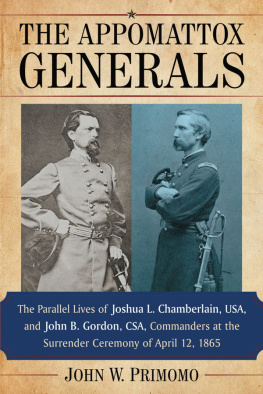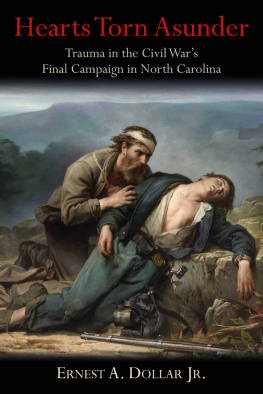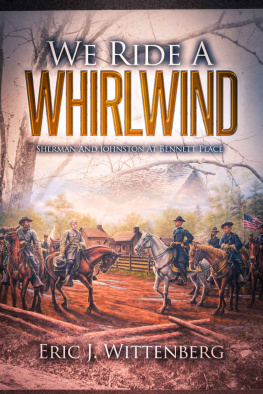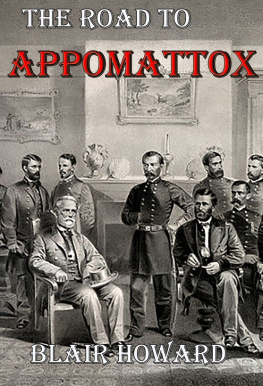
The Appomattox Generals
The Parallel Lives of Joshua L. Chamberlain, USA, and John B. Gordon, CSA, Commanders at the Surrender Ceremony of April 12, 1865
John W. Primomo

McFarland & Company, Inc., Publishers
Jefferson, North Carolina, and London
LIBRARY OF CONGRESS CATALOGUING DATA ARE AVAILABLE
BRITISH LIBRARY CATALOGUING DATA ARE AVAILABLE
e-ISBN: 978-1-4766-0581-4
2013 John W. Primomo. All rights reserved
No part of this book may be reproduced or transmitted in any form or by any means, electronic or mechanical, including photocopying or recording, or by any information storage and retrieval system, without permission in writing from the publisher.
Front cover: Generals John B. Gordon, CSA (left; National Archives and Records Administration) and Joshua L. Chamberlain, USA (Maine Historical Society).
McFarland & Company, Inc., Publishers
Box 611, Jefferson, North Carolina 28640
[link:www.mcfarlandpub.com]
For Marilyn, Meredith and Mallory
Preface
The Civil War was the dening event in the history of the postRevolution United States. Historians have calculated that at least 620,000, and as many as 750,000, men lost their lives in the bloody, devastating war. Ultimately, the Civil War also determined that slavery would no longer be tolerated in this country. However, it was secession that caused most men to choose to ght either for the United States of America or the Confederate States of America. The armies were made up of all types of men from all walks of life. In my many years of Civil War studies, no two soldiers presented stories as fascinating and with such remarkable similarity as those of Joshua Lawrence Chamberlain of Maine and John Brown Gordon of Georgia.
Both men volunteered for military service, feeling a strong need to ght for the cause of their respective sections. They entered the army as low-level ofcers with no formal military training. Repeatedly, they exhibited exceptional aptitude and command, rising through the ranks as they received the glowing accolades of their superiors. Yet, they remained humble and continually demonstrated exceptional courage, which earned them the respect of their men. Ultimately, as fate would have it, their heroism and leadership culminated in their meeting as the commanders of the Union and Confederate armies at the Appomattox Courthouse surrender. At Chamberlains command, the Union army saluted the Confederates as they laid down their arms and ags. In turn, Gordon ordered his men to return the noble gesture of respect.
While others have written about Chamberlain and Gordon individually, the comparison of the lives of these two remarkable soldiers in one manuscript is original and compelling. This book traces the lives of Cham[HYPHEN]berlain and Gordon from their youths to the outbreak of the Civil War. It recounts the battles in which they engaged, including the Peninsula Campaign, Antietam, Fredericksburg, Chancellorsville, Gettysburg, the Wilderness, Spotsylvania Courthouse, Petersburg, the Monocacy River and Shenandoah Valley, Fort Stedman, Quaker Road to Five Forks, and, nally, Appomattox. The book also discusses the lives of Chamberlain and Gordon after the Civil War as both men, whose heroics had made them popular gures, entered politics in their respective states.
Information for this book was obtained from the Ofcial Records of the Union and Confederate Armies, the recollections of Chamberlain and Gordon, and descriptions of both men by soldiers who fought with them and those who fought against them. The high esteem in which both men were held is reected in the fact that material was drawn not only from the superior ofcers they served but also from the men who served under them. Additionally, works of various noted historians contributed to this effort.
While, inevitably, troop movements and battle maneuvers must be addressed in any work of this kind, I have attempted to minimize and simplify those discussions and focus instead on the characters of Chamberlain and Gordon that made them such extraordinary men and soldiers. Also, any explanation which did not involve Chamberlain and Gordon but which was necessary for purposes of completeness and context has been abbreviated. Justiably, some readers will nd these men awed; e.g., Gordon apparently belonged to the Ku Klux Klan for a brief period after the Civil War. This book is about two goodnot perfectmen, whose faults should be judged according to the time in which they lived. By the standards of yesterday and today, the positive attributes of Chamberlain and Gordon that made them so remarkable are unsurpassed and deserve imitation by every American, whether living on Main Street, working on Wall Street, or, perhaps most important, serving in a state or the federal government.
Introduction
Wednesday April 12, 1865, dawned chilly and gray as the ragged and exhausted remnants of the surrendered Army of Northern Virginia folded their tents and broke camp for the last time. With heavy hearts, they reluctantly prepared to march from the banks of the Appomattox River through the village of Appomattox Courthouse, Virginia, to relinquish their ags and arms to the victorious Union army. It was four years to the day, almost to the very hour, since military forces of the Confederate States of America inaugurated the American Civil War by ring upon Fort Sumter in Charleston Harbor, South Carolina. They had come to this bitter point not through any failure of spirit, but only because further resistance would have proved futile. Commanded by Lieutenant General Robert E. Lee, the Army of Northern Virginia had suffered through a nine-month siege around Petersburg and Richmond, Virginia, at the hands of the Union Army of the Potomac and the Army of the James led by Lieutenant General Ulysses S. Grant. Confederate lines, continuously lengthened and defended by fewer and fewer soldiers, nally collapsed in early April 1865 under the weight of implacable Federal assaults. Within a week, Lees retreating army of 27,000, most of whom were too feeble to ght, was trapped at Appomattox Courthouse by well-fed and well-equipped Union forces numbering in excess of 60,000.
Lee and Grant met in the home of Wilmer McLean on April 9, Palm Sunday, and agreed to the terms of surrender. Though Lee wished that the Confederates be allowed to simply leave their arms and ags in their camp and go home, Grant felt that a formal surrender ceremony was necessary to demonstrate proper respect for the United States. Neither Grant nor Lee would be present for that event, however. Leading the Confederate procession would be Major General John Brown Gordon of Georgia, who entered the war in April 1861 as a lowly captain of volunteers yet now commanded the Second Corps of the Army of Northern Virginia. Despite his having had no military training when the war began, Gordons bravery and skill in battle soon garnered the attention of his superiors and the respect of his men. At the Battle of Antietam in September 1862, he was wounded ve timesonce, grievously, through the face. Promotions and accolades followed Gordon throughout the war until, by April 1865, he was one of Lees most trusted condants.

Next page











